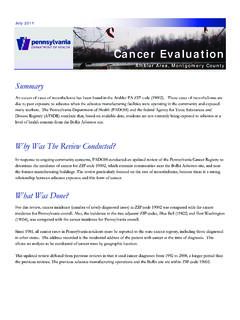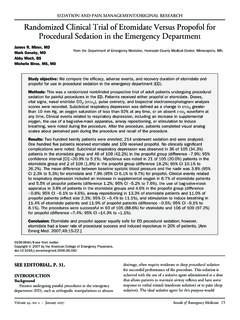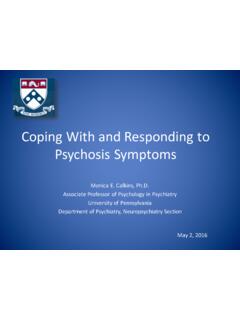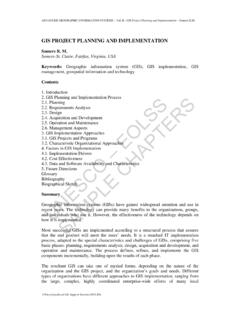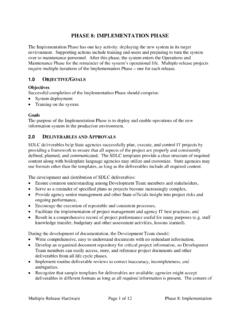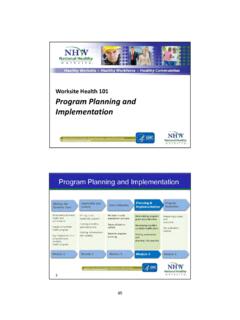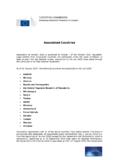Transcription of Treatment Planning - Perelman School of Medicine at the ...
1 Treatment . Planning . Lyndsay Schmidt, Penn Psychosis Evaluation and Recovery Center University of Pennsylvania Department of Psychiatry Neuropsychiatry Section Treatment Planning Person Centered approach Focus on the individual and their goals Strengths, preferences, support systems Necessary to identify current issues Provides guidance for Treatment Allows for assessing progress over time Collaborative effort Responsibility and motivation is shared Signatures, regular adjustments, and timeframe Treatment Planning Three steps to creating a Treatment plan 1. Assessment 2. Formulation 3. implementation Assessment Why is the individual seeking help? How have these problem's affected the individuals life? What are the precipitating, perpetuating, predisposing, and protective factors?
2 What do they hope to gain? Assessment and Formulation Presenting problem History with the problem Family, Social, Educational, Employment, Medical and Mental Health history Individual characteristics: Symptoms of mood, anxiety, unusual thoughts and perceptions Level of impairment Distress Risk of harm (self and others). Motivation Willingness or resistance Support Coping Formulation Goals should be SMART: Specific Measurable Achievable Realistic Timely Integrative effort with other team members Medication management Cognitive remediation Clinical team Identify specific interventions Practical Assist in achieving goals Meets the individual at his/her level of functioning implementation Engagement Genuine Unconditional positive regard Accurate empathy Respect Maintain the same structure Set plans for sessions Identify obstacles Create assignments On-going assessments and adjustments Celebrate successes Example of a PERC Treatment Plan Participant:(_____(.))
3 (. Date:(_____(. ( (. Treatment (Plan:(Neuropsychiatry(. ( ( ( ( ( Medical(Record(#:(_____(. Initial(((((((((((((((((((((((((((((((Up date(. Initial(Tx(Plan(date:(_____(( ( ( ( Next(TX(Plan(Update:(_____(. (. Strengths:(_____( (((((((((((((((((((((((((Diagnosis:((((( ((Axis(I:(_____(. (((((. Barriers((Internal/External):(_____(( ((((((((((((((((((((((((((((((((((Axis(I I:(_____((. ( ( ( ( ( ( ( ( ( ( ( ( ( ( ( (((. Progress(towards(goals(since(last(Tx(pla n:(_____((( ( ((((((((((((((((Axis(III:(_____(. (. _____(( ( ((((((((((((((((Axis(IV:(_____(. (. ( ( ( ( ( ( ( ( ( ( ( ( ( ( ((((((((((((((((Axis(V:(_____(. Target(Symptoms(( Goals(( Objectives( Modalities/(Frequency(of(TX( Person(s)(Responsible( Expected(Duration(. (Behaviorally(Defined)( (Desired(Outcomes)( (Measurable)( (Specific(interventions)( (for( implementation )(.)))))))))))))))))) )))))))))))))))))))))))))))))))))))))))) )))))))))))))))))))))))))))))))))))))))) )))))))))))))))))))))))))))))))))))))))) )))))))))))))))))))))))))))))))))))))))) )))))))))))))))))))))))))))))))))))))))) )))))))))))))))))))))))))))))))))))))))) ))))))))))))))))))
4 1.( 1.( 1.( 1.( 1.( 1.(. 2.( 2.( 2.( 2.( 2.( 2.(. 3.(( 3.( 3.( 3.( 3.( 3.(. (. Participant(signature:(_____Date:(_____( (((Therapist(signature:(_____(Date:(____ _(. (. Supervisor(signature:(_____Date:(_____(( (Psychiatrist(signature:(_____(Date:(___ __(. Target Symptoms Goals Objectives Modalities/Frequency Persons Responsible Expected Duration (Behaviorally (Desired outcomes) (Measurable) (Specific defined) Interventions). X experiences X will reduce the X will learn to 1. The counselor will X- Participant 90 days auditory/visual provide psychoeducation frequency of auditory implement at least 2 on diagnosis and hallucinations, hallucinations. to 3 effective coping symptoms. Counselor everyday, appx. 4-6 skills to reduce the 2. X and the counselor will times a day. frequency of identify possible coping skills ( PMR, "Look- auditory/visual Point-Name", activity hallucinations.))))))))))))))))))))))))) ))))))))))))))))))))
5 Scheduling) to reduce the attention on hallucinations. 3. X and the counselor will practice implementing skills in session. X reported feelings of X symptoms of X will develop 1. Counselor will provide X-Participant 90 days psychoeducation on anxiety on a anxiety will strategies to reduce anxiety. somewhat daily basis, significantly reduce to feelings of anxiety as 2. Counselor and X will Counselor which limits her no longer interfere evidenced by a identify and practice ability to interact with with his/her daily decreased score on implementing effective coping skills to manage others or leave the functioning. the BAI. anxiety. home. 3. Counselor will aid X in identifying feelings, thought distortions, and/or events that could lead to anxious symptoms. X experiences X will develop healthy X will replace 1.
6 X will verbalize X-Participant 90 days understanding of how to depressed mood and cognitive patterns negative and self- use her/his supports when suicidal ideations and beliefs about self defeating self-talk experiencing suicidal Counselor everyday. and the world that with verbalization of thinking. lead to alleviation of realistic and positive 2. X and the counselor will explore how depression is depressive cognitions as experienced in his/her day- symptoms. evidenced by a to-day life through decreased score on targeting cognitions that the BDI. support depression. 3. The counselor and X will practice using thought records to track negative automatic thinking that leads to depressed mood and suicidal ideations. Target Symptoms Goals Objectives Modalities/Frequency Persons Responsible Expected Duration (Behaviorally defined) (Desired outcomes) (Measurable) (Specific Interventions).
7 X has struggled with X will connect with X will create a list of 1. X and the counselor will X-Participant 90 days identify her/his particular maintaining a job and community resources possible vocational educational and vocational School functioning for additional support pursuits and interests. Counselor over the past 6 in re-establishing the community agencies 2. X will explore and months. ability to work and/or that support collaboratively contact community agencies that aid participate in School . vocational in vocational rehabilitation. rehabilitation. 3. The counselor will aid X in practicing to reframe cognitions and implement positive self-talk in order to increase his/her confidence in the ability to work. The End Questions or comments?



